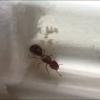You are definitely correct about ants being on their own biological clock, however from research and reading about other ant keepers experiments, you can also control when they hibernate. This is not for all ants though, some will hibernate regardless of what you do as far as heating them or cooling them, and some will rely on you to be their biological clock and will not hibernate until properly cooled.
I can think of a few reasons as to why your ants may be foraging. It could be that they are hungry and are simply just looking for food, which has the possibility of them being in hibernation or not, because again I have seen ants in hibernation forage and accept food and ants that don't. I personally try and feed my ants at least once a month during hibernation just in case. This also keeps the colony healthy and virtually none of your ants die over the hibernation period from starvation and will only die from old age. I would recommend trying to feed them something just to be safe, such as a drop of honey or an insect.
Two other possibilities would be that they are not at a low enough temperature, for most species that hibernate I recommend a temp of 37F to 47F. That should be low enough. Whatever specific temperature they are at may be too high resulting in them believing hibernation is over, or that may just be their decision in that they've had enough hibernation time which would be perfectly fine.
I'm sorry that this was very vague and may not be very helpful, but there is still much we have to learn and discover about ants and their behaviour. All in all, I wouldn't worry too much about this, you should probably just offer some food and continue trying to hibernate them until spring even if they are active and foraging however it is up to you. Just know that for most ants a healthy hibernation period is 3 to 5 months. This year for myself, I started hibernating my ants at the start of October (even though temperatures hadn't dropped yet and most ants were still active outside) and then just brought them out last week (giving them about 3 and a half months of hibernation) and temps are still freezing outside and it is still snowing and they seem to have been doing just fine and a few have already begun laying eggs again.
I hope this helped and everything works out with your ants.
Edited by Karma, January 15 2018 - 5:56 PM.






















